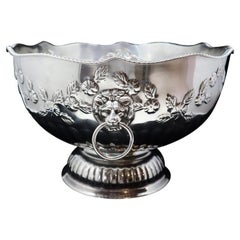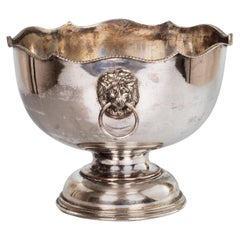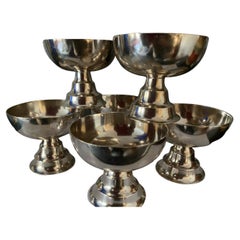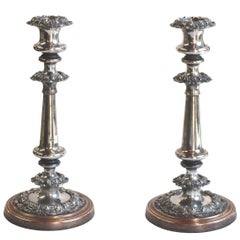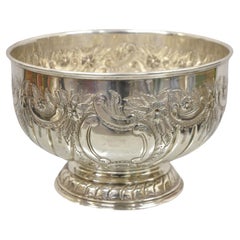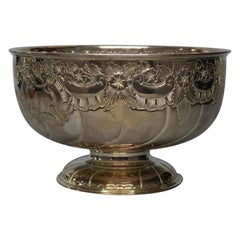Sheffield Serving Bowls
2
to
2
2
2
2
2
2
2
2
2
2
19
47
33
32
23
Creator: Sheffield
Sheffield, England, 20th Century Silver Plated, Hallmarked
By Sheffield
Located in Lantau, HK
A Sheffield made mid-20th century silver plated punch bowl with lion heads serving as handles.
The silver plate on a copper base.
Hallmarked on the bottom of the base for “Silver o...
Category
Mid-20th Century English Sheffield Serving Bowls
Materials
Silver
Sheffield, England, 20th Century Silver Plated, Hallmarked
By Sheffield
Located in Lantau, HK
A Sheffield made mid-20th century silver plated punch bowl with lion heads serving as handles.
The silver plate on a copper base.
Hallmarked on the bottom of the base for “Silver o...
Category
Mid-20th Century English Sheffield Serving Bowls
Materials
Silver
Related Items
Art Deco Silver-Plated Ice Cream Bowls '6 Items'
Located in Waddinxveen, ZH
6 Lovely ice cream bowls, they have a very nice Art Deco base.
Category
1930s French Art Deco Vintage Sheffield Serving Bowls
Materials
Silver Plate
19th Century Georgian, Sheffield Silver Plate Candlesticks, Pair
By Sheffield
Located in Soquel, CA
19th Century Georgian, Sheffield Silver Plate Candlesticks, Pair
Pair of English, Georgian, George IV Sheffield silver plate candlesticks. Vintage, distressed silver finish. Silver ...
Category
1820s English George IV Antique Sheffield Serving Bowls
Materials
Sheffield Plate, Copper
Ellis Barker, Antique Silver Plate Candlestick, England, Early 20th Century
By Ellis Barker
Located in Chatham, ON
Ellis Barker Silver Co. - antique single silver-plate candlestick - large size - finely chased - weighted base - menorah hallmark / stamp to the base rim ...
Category
Early 20th Century British Victorian Sheffield Serving Bowls
Materials
Silver Plate
Antique English Silver Plated Partitioned Serving Bowl or Condiment Dish
Located in Hamilton, Ontario
This antique serving dish is hallmarked by an unknown English maker, and believed to date to approximately 1910-1920 and done in a Victorian style...
Category
Early 20th Century English Victorian Sheffield Serving Bowls
Materials
Silver Plate
Pair George III Old Sheffield Silver Plated Three Light Candelabras.
By Sheffield
Located in Vero Beach, FL
Pair George III Old Sheffield Silver Plated Three Light Candelabras.
Elegant pair of 19th century Georgian Sheffield Silver Plate thre...
Category
19th Century English George III Antique Sheffield Serving Bowls
Materials
Silver Plate
20th Century Silver Plate Tableware Charger / Under Plate
Located in Tarry Town, NY
Elegant and beautiful North American silver plate tableware charger / under plate service for twelve people . Each charger / underplate is in great conditi...
Category
Mid-20th Century North American Sheffield Serving Bowls
Materials
Silver Plate, Copper
Hallmarked Silver Plated Keepsake Box, Sheffield, Uk, Circa 1900
Located in Colorado Springs, CO
Offered is a stunning Sheffield silver keepsake box dating to 1900, with associated hallmark. This small box includes a clean interior and rounded corners. The box is free of names or initials, but would have been used to house keepsakes such as jewelry or cufflinks. A well maintained, elegant piece, this antique silver box is an excellent addition to any silver collection.
Trinket or keepsake boxes have taken on many forms since their first conception in ancient times. However their purpose remains the same; to store jewelry and other items precious to the owner. Originally, these boxes were used specifically for jewelry. These were in common use as early as 5000 BC in Ancient Egypt, when the majority of Egyptians, both male and female, wore jewelry. Boxes were used to keep these gemstone encrusted items safe. In Ancient Rome, jewelry was a status symbol. Rings and brooches were utilized to represent ones status in society. Again, boxes were needed for security and storage purposes. Finding early examples of these are quite rare.
Victorian and Edwardian examples of trinket boxes are far more common. This is because owning jewellery was a luxury until the Victorian era- let alone possessing so much a box was needed to store it all. Fine jewelry and other items became available to the masses after the industrial revolution due to the reduction in production costs. This led to a demand for trinket boxes, which were much smaller than jewelry boxes and therefore better suited to the needs of the middle class who did not yet possess an abundance of jewelry.
In Victorian households, collectables and other items of interested were also stashed inside these boxes. This is why they are known as trinket or keepsake boxes, rather than just jewelry boxes, although of course jewelry was also stored in them. Trinket boxes were produced in large numbers around this time. Many were lined with colored plush or velvet or rich wood. More elaborate designs had interior divisions and trays for rings and other pieces of jewellery. It was also common to see trinket boxes so small that they could only contain one item, such as a single ring. Ornate exteriors were created to reflect the value of the trinket boxes contents.
The Edwardian era saw the introduction of new styles of trinket box. These included small circular or oblong boxes...
Category
Early 1900s British Art Deco Antique Sheffield Serving Bowls
Materials
Silver
Redfield & Rice Silver Plated Etruscan Handled Bowl with Classical Motifs
Located in New York, NY
This refined antique handled bowl was produced by Redfield & Rice- an esteemed producer of silver wares based in New York State. The bowl has a flat ovoid centre and steeply sloped sides. The two curved handles are connected via a flat rectangular rod with two orbital finials. On the interior ends of the bowl, there are two identical busts of a Greek male figure...
Category
19th Century American Victorian Antique Sheffield Serving Bowls
Materials
Silver Plate
H 3.5 in W 13.5 in D 7.5 in
Hallmarked Silver Plated Keepsake Box, Sheffield, UK, circa 1900
Located in Colorado Springs, CO
Offered is a stunning silver plated keepsake box dating to 1900, with associated hallmark. This small box includes a wooden interior with two slots and a blank square on top where initials could have been engraved. A well maintained, elegant piece, this antique silver box is an excellent addition to any silver or home decor collection.
Trinket or keepsake boxes have taken on many forms since their first conception in ancient times. However their purpose remains the same; to store jewelry and other items precious to the owner. Originally, these boxes were used specifically for jewelry. These were in common use as early as 5000 BC in Ancient Egypt, when the majority of Egyptians, both male and female, wore jewelry. Boxes were used to keep these gemstone encrusted items safe. In Ancient Rome, jewelry was a status symbol. Rings and brooches were utilized to represent ones status in society. Again, boxes were needed for security and storage purposes. Finding early examples of these are quite rare.
Victorian and Edwardian examples of trinket boxes are far more common. This is because owning jewellery was a luxury until the Victorian era- let alone possessing so much a box was needed to store it all. Fine jewelry and other items became available to the masses after the industrial revolution due to the reduction in production costs. This led to a demand for trinket boxes, which were much smaller than jewelry boxes and therefore better suited to the needs of the middle class who did not yet possess an abundance of jewelry.
In Victorian households, collectables and other items of interested were also stashed inside these boxes. This is why they are known as trinket or keepsake boxes, rather than just jewelry boxes, although of course jewelry was also stored in them. Trinket boxes were produced in large numbers around this time. Many were lined with colored plush or velvet or rich wood. More elaborate designs had interior divisions and trays for rings and other pieces of jewellery. It was also common to see trinket boxes so small that they could only contain one item, such as a single ring. Ornate exteriors were created to reflect the value of the trinket boxes contents.
The Edwardian era saw the introduction of new styles of trinket box. These included small circular or oblong boxes...
Category
Early 1900s English Art Deco Antique Sheffield Serving Bowls
Materials
Silver
Hand-Hammered Silver Plate Italian Bowl or Serving Bowl
Located in North Miami, FL
This lovely vintage hand-hammered silver plate Italian bowl is hallmarked on the bottom: Battuto a Mano-silver plated. It is perfect for so many uses and occasions and for serving. I...
Category
1970s Italian Modern Vintage Sheffield Serving Bowls
Materials
Silver Plate
Regency Sheffield Silver Plate Bread Basket, England, circa 1820
Located in San Francisco, CA
Large Sheffield silver plate Regency period gondola shape bread basket with loop ring handles, England, early 19th century.
Category
Early 19th Century English Regency Antique Sheffield Serving Bowls
Materials
Silver Plate
20th Century Silver Plate Pocket Emptier
Located in Casale Monferrato, IT
Beautiful 20th century silver plate pocket emptier. Refined finely chiseled decorations. Perfect for embellishing a desk with class.
Category
1930s English Vintage Sheffield Serving Bowls
Materials
Silver Plate
Previously Available Items
Sheffield Silver Plate Repousse Punch Bowl Champagne Wine Chiller Bucket
By Sheffield
Located in Philadelphia, PA
Sheffield silver plate repousse punch bowl champagne wine chiller bucket. Circa 1900. Measurements: 8" height x 12.25" diameter.
Category
Early 20th Century Victorian Sheffield Serving Bowls
Materials
Silver Plate
Vintage English Sheffield Silver Plate Repousse Punch Bowl, circa 1930
By Sheffield
Located in Big Flats, NY
A vintage English Sheffield punch bowl offers silver plate construction with melon twist bowl having floral repousse collar and raised on flared f...
Category
Mid-20th Century English Sheffield Serving Bowls
Materials
Metal, Silver Plate
Sheffield serving bowls for sale on 1stDibs.
Sheffield serving bowls are available for sale on 1stDibs.
Creators Similar to Sheffield
Questions About Sheffield Serving Bowls
- What is Sheffield plate?1 Answer1stDibs ExpertSeptember 25, 2019
Sheffield plate is a layered combination of silver and copper.
- 1stDibs ExpertMarch 22, 2022On silver, the word "Sheffield" means that the piece features Sheffield plate, a finish made up of layers of silver and copper. Most Sheffield silver items originate from Sheffield, England, where craftsmen pioneered the technique in 1743. On 1stDibs, find a variety of Sheffield silver.
- What is Sheffield silver plate?1 Answer1stDibs ExpertApril 5, 2022Sheffield silver plate usually refers to electroplated silverware produced in Sheffield, England. Prior to electroplating, Sheffield silver was associated with a particular process of layered construction which consisted of copper and silver. Today, this older form of silver is usually referred to by collectors as “Old Sheffield Silver Plate.” Shop a collection of Sheffield silver from some of the world’s top sellers on 1stDibs.
- Are Sheffield knives any good?1 Answer1stDibs ExpertMarch 25, 2024Yes, many people say that Sheffield knives are good. Specifically, experts and online reviewers often tout the brand's price-to-quality ratio, stating that its cutlery is well made and durable yet economically priced. The company's history of producing cutlery dates back more than 700 years to its founding in 1297. Explore a range of Sheffield knives on 1stDibs.
- 1stDibs ExpertApril 5, 2022Up until 1974, the silver hallmark for Sheffield Silver was the crown, although the origin and connotation of the symbol is not known. You can find a variety of silver products from some of the world’s top sellers on 1stDibs.
- 1stDibs ExpertApril 5, 2022Yes, Viners cutlery is made in Sheffield. According to its website, Viners company was established in Sheffield, United Kingdom and in 1912 it established its factory on Bath Street in Sheffield. On 1stDibs, find a collection of authentic Viners pieces from some of the world’s top sellers.
- Is Sheffield silver real silver?1 Answer1stDibs ExpertApril 5, 2022Yes, Sheffield silver is part real silver, part copper. Sheffield manufactured what is known as a Sheffield plate, which is a “double sandwich” form of plating—it has a sheet of silver on each side of a piece of copper. Shop a selection of Sheffield pieces on 1stDibs.
- 1stDibs ExpertApril 5, 2022Sheffield plates were created in 1742 with production ceasing by the 1870s. The process fused silver and copper together to create utensils and serve ware. Work with a certified appraiser to determine the age and authenticity of your Sheffield plate item. On 1stDibs, you’ll find expertly vetted Sheffield serve ware and collectibles.
